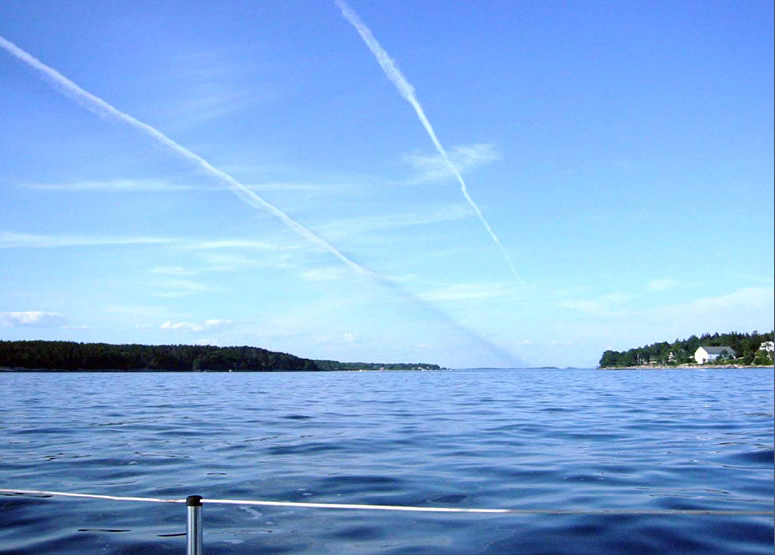Contrail Shadows
Contrail Shadows: A Closer Look at the Dark Side of Contrails
Contrails, short for condensation trails, are a familiar sight in the sky. These wispy streaks formed by ice crystals and supercooled water droplets are created when hot exhaust gases from aircraft engines mix with the cold air at high altitudes. While contrails themselves have been extensively studied, there is another intriguing phenomenon associated with them: contrail shadows. In this article, we will delve deeper into the world of contrail shadows, exploring their characteristics and shedding light on their enigmatic nature.
Contrails, once formed, can persist for varying lengths of time depending on atmospheric conditions. The presence of contrails in the sky has increased over the years due to advancements in aircraft technology and the higher number of planes in operation. Consequently, the occurrence of contrail shadows has also become more prevalent.
Contrail shadows appear as dark areas in the sky, contrasting against the brighter surroundings. Similar to cloud shadows, these shadows are three-dimensional volumes of unlit air. The reason for their darkness lies in the absence of direct sunlight. The surrounding sunlit air appears brighter because haze particles scatter sunlight, making it more diffuse. Contrail shadows, on the other hand, remain unlit, creating a stark contrast.
Interestingly, not all contrail shadows are three-dimensional. Some contrail shadows are cast downwards onto the screen of a lower cloud layer, resulting in a two-dimensional projection. This adds to the complexity and diversity of these atmospheric phenomena.
To better understand contrail shadows, it is essential to consider their formation and interaction with different atmospheric elements. Contrails themselves are formed when water vapor in the aircraft exhaust freezes into ice crystals. These ice crystals can then grow and spread, forming a visible trail behind the aircraft. When sunlight passes through these ice crystals, it scatters in various directions, creating a bright streak in the sky. However, in the presence of a contrail shadow, the sunlight is obstructed, resulting in a darker area.
Contrail shadows can exhibit intriguing optical effects, adding to their allure. In certain atmospheric conditions, they may display iridescent colors, similar to those seen in thin clouds or soap bubbles. These colors arise from the diffraction and interference of light waves as they pass through the ice crystals in the contrail shadow. This mesmerizing display further highlights the complexity and beauty of atmospheric optics.
The study of contrail shadows not only contributes to our understanding of atmospheric phenomena but also has practical implications. By examining contrail shadows and their behavior, scientists can gain insights into the composition and properties of the atmosphere at different altitudes. This knowledge is crucial for improving climate models and understanding the impact of aviation on the environment.
In conclusion, contrail shadows are captivating features that accompany the formation of contrails in the sky. These dark areas, contrasting against the brighter surroundings, add depth and intrigue to our observations of atmospheric optics. With their three-dimensional and two-dimensional variations, as well as their potential for displaying iridescent colors, contrail shadows offer a fascinating glimpse into the complexities of our atmosphere. By studying these phenomena, scientists continue to expand our knowledge of the atmosphere and its interactions with human activities.

Contrail and Shadow
Imaged by Andrew Baker while sailing off the coast of Maine.
Contrails are ice crystals and supercooled water droplets condensed during the airflow over aircraft wings and from water generated by burning fuel.
Paradoxically, modern higher efficiency airplanes and engines produce contrails over a wider range of air conditions than do older craft. For this reason, and the greater number of aircraft flying, we see more of them.
This dark shadow is a three-dimensional volume of unlit air like those of cloud shadows. The surrounding sunlit air is brighter because haze scatters the light. Other contrail shadows are two dimensional ~ cast downwards onto the screen of a lower cloud layer.
Image ©Andrew Baker, shown with permission.
Note: this article has been automatically converted from the old site and may not appear as intended. You can find the original article here.
Reference Atmospheric Optics
If you use any of the definitions, information, or data presented on Atmospheric Optics, please copy the link or reference below to properly credit us as the reference source. Thank you!
-
<a href="https://atoptics.co.uk/blog/contrail-shadows-3/">Contrail Shadows</a>
-
"Contrail Shadows". Atmospheric Optics. Accessed on November 26, 2024. https://atoptics.co.uk/blog/contrail-shadows-3/.
-
"Contrail Shadows". Atmospheric Optics, https://atoptics.co.uk/blog/contrail-shadows-3/. Accessed 26 November, 2024
-
Contrail Shadows. Atmospheric Optics. Retrieved from https://atoptics.co.uk/blog/contrail-shadows-3/.